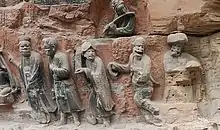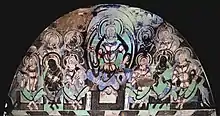Six Heretical Teachers
The Six Heretical Teachers, Six Heretics, Six Śramaṇa, or Six Tirthakas (false teachers) were six sectarian contemporaries of the Buddha, each of whom held a view in opposition to his teachings.[1][2]
| The views of six śramaṇa in the Pāli Canon (based on the Buddhist text Sāmaññaphala Sutta1) | |
| Śramaṇa | view (diṭṭhi)1 |
| Pūraṇa Kassapa |
Amoralism: denies any reward or punishment for either good or bad deeds. |
| Makkhali Gośāla (Ājīvika) |
Niyativāda (Fatalism): we are powerless; suffering is pre-destined. |
| Ajita Kesakambalī (Lokāyata) |
Materialism: live happily; with death, all is annihilated. |
| Pakudha Kaccāyana |
Sassatavada (Eternalism): Matter, pleasure, pain and the soul are eternal and do not interact. |
| Nigaṇṭha Nātaputta (Jainism) |
Restraint: be endowed with, cleansed by and suffused with the avoidance of all evil.2 |
| Sañjaya Belaṭṭhiputta (Ajñana) |
Agnosticism: "I don't think so. I don't think in that way or otherwise. I don't think not or not not." Suspension of judgement. |
| Notes: | 1. DN 2 (Thanissaro, 1997; Walshe, 1995, pp. 91-109). 2. DN-a (Ñāṇamoli & Bodhi, 1995, pp. 1258-59, n. 585). |
The six heretics and their views on Indian philosophy are described in detail in the Samaññaphala Sutta of the Digha Nikaya in the Pali Tipitaka.[3]

Background

According to the sutra, King Ajatashatru visited Gautama Buddha, who, at the time, was living in the mango grove of Jīvaka in Rajagaha among 1250 bhikkhus. The king posed the Buddha the question of whether or not it was possible that the life of a śramaṇa could bear fruit in the same way as the lives of craftsmen bear fruit, declaring that he had previously asked six teachers (Pūraṇa Kassapa, Makkhali Gosāla, Ajita Kesakambala, Pakudha Kaccāyana, Nigaṇṭha Nāṭaputta and Sañjaya Belaṭṭhaputta) the same question, yet had not found a satisfactory answer. At the Buddha's request, King Ajatashatru describes, the answers given to him by the six other teachers.[4]
The names below are provided in Sanskrit, with the equivalent Pali names given in parentheses.
Pūrṇa Kāśyapa (Pūraṇa Kassapa)
The first spiritual teacher to whom Ajatashatru posed his question was Pūraṇa Kassapa. Kassapa posited the theory of akiriyāvāda (non-doing): actions considered good and evil carried no inherent morality and thus there exists no future consequence from committing either "good" or "evil" deeds.[5]
Maskarī Gośālīputra (Makkhali Gosāla)
Makkhali Gosāla, the second teacher visited by Ajatashatru, subscribed to the doctrine of non-causality;[6] the attainment of any condition is dependent on circumstance, fate, or nature rather than human will and events lack in root cause.[7][8] Like Kassapa, Gosāla denied the existence of karma and vipaka. This doctrine has been likened to fatalism and determinism.
Ajita Keśakambala (Ajita Kesakambala)
Ajita Kesakambala followed Gosāla as the third teacher mentioned by Ajatashatru. Kesakambala followed "ucchedaditthi" (often translated as nihilism or annihilationism) and is frequently understood to be a materialist. Kesakambala held that all in existence was merely the process of natural phenomena and vehemently denied the existence of any life after death; "A man is built up of the four elements', when he dies, earth returns to the aggregate of earth, water to water, fire to fire, air to air, and the senses vanish into space."[5]
Kakuda Kātyāyana (Pakudha Kaccāyana)
Pakudha Kaccāyana, the fourth teacher referred to by Ajatashatru, was an atomist who posited that all things were made up of earth, fire, air, water, pleasure, pain, and the soul, which were unchangeable and eternal. Thus objects, like living beings, composed of the elements are subject to change, while the elements themselves are absolutely fixed in their existences. Thus similarly to materialism, actions are defined solely by the physical interaction between these substances, rather than the moral value ascribed to them.[5]
Nirgrantha Jñatiputra (Nigaṇṭha Nāṭaputta)
Nigaṇṭha Nāṭaputta (also known as Mahavira), regarded as the most recent tirthankara within Jainism, was the fifth teacher who Ajatashatru questioned. Nāṭaputta answered Ajatashatru with a description of Jain teachings, which, unlike the previous teachers recognized morality and consequences in the afterlife. The philosophy of Nāṭaputta, however, varied from that of Buddha in its belief that involuntary actions, like voluntary actions, carry karmic weight; Buddhism holds that only actions with intention have the potential to generate karma.[6]
Saṃjaya Vairāṣṭrikaputra (Sañjaya Belaṭṭhaputta)
Sañjaya Belaṭṭhaputta was the sixth and final teacher referenced by Ajatashatru. Belaṭṭhaputta did not provide Ajatashatru with a clear answer to his question one way or another, leading some scholars to align him with Ajñana, an agnostic school of Indian philosophy which held that metaphysical knowledge was impossible to obtain.
See also
References
- Green, Arnold L.; Coomaraswamy, Ananda (1965). "Buddha and the Gospel of Buddhism". The Journal of Asian Studies. 24 (3): 547. doi:10.2307/2050403. hdl:2027/hvd.32044010328052. ISSN 0021-9118. JSTOR 2050403.
- "Six heretical teachers | Encyclopedia.com". www.encyclopedia.com. Retrieved 2019-01-02.
- Alex., Wayman (1997). Untying the knots in Buddhism : selected essays. Motilal Banarsidass Publishers. ISBN 978-8120813212. OCLC 925708140.
- "Samaññaphala Sutta: The Fruits of the Contemplative Life". www.accesstoinsight.org. Retrieved 2019-01-02.
- "Six Contemporary Teachers During The Time Of The Buddha" (PDF). stylomilo.com. Retrieved 2019-01-02.
- Velez de Cea, J. Abraham (2013-01-03). The Buddha and Religious Diversity. doi:10.4324/9780203072639. ISBN 9780203072639.
- Malalasekera, G. P. (2003). Dictionary of Pali Proper Names, Volume 1. ISBN 9788120618237.
- Sayadaw, Pa-Auk Tawya (2012). The Workings of Kamma. Pa-Auk Meditation Centre (Singapore).